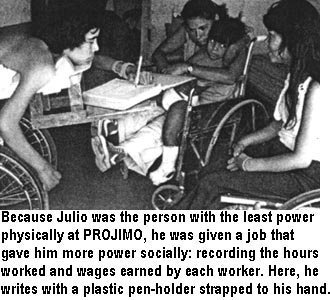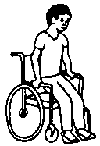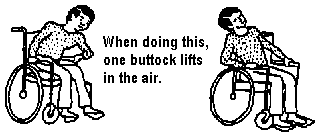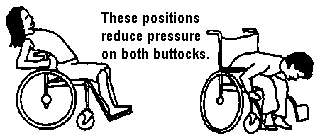CHAPTER 28
Julio Uses His Spasticity to Prevent Pressure Sores

JULIO was 15 years old when his six-year-old
sister, playing with their father's pistol, accidentally shot him in the
neck. From this injury Julio became quadriplegic (paralyzed in all 4
limbs). When he was taken to PROJIMO several months later, he had a deep,
infected pressure sore over his sacrum (the bottom end of his backbone).
The sore had already destroyed the end of his spine. It took months of
treatment with bees' honey mixed with sugar for the sore to heal. (For
information on treatment of pressure sores with honey and sugar see
page 156.)
Preventing More Sores. After Julio's pressure sore had
healed and he could sit in a wheelchair, the PROJIMO team wanted to make
sure that further sores were prevented. They provided Julio with a good
cushion, and helped him explore ways to take the pressure off hfs backside
at frequent intervals. For Julio, this was not easy.

For a person with paraplegia (paralysis of the lower
part of the body), pressure relief is easy. He simply uses his arms to
lift his buttocks off the seat every 10 or 15 minutes. This allows blood
to circulate in the skin and flesh of the backside, thus preventing sores.
But for someone with quadriplegia, whose arms, too,
are partly or completely paralyzed, lifting the body to reduce pressure is
more difficult.
The following positions can relieve some pressure on the backside:


However, for a quadriplegic person, none of the above positions is
simple or comfortable. Without great care and self-discipline, such
persons often develop new pressure sores.
Spasticity: Hindrance or Help. Many spinal-cord
injured persons have a lot of spasticity (involuntary tightening of
muscles), especially in their lower body and legs. Spasticity can be very
bothersome and make some actions more difficult, such as bending forward
to tie shoes, or to relieve pressure on the backside while seated.
However, many spinal cord injured persons learn to use their spasticity
to good advantage. For example, some persons use the spastic straightening
of their legs to transfer from their wheelchair to a bed, a car, or a
toilet. Others use it to stand or walk with crutches but without leg
braces. Each spinal-cord injured person should be encouraged to experiment
with new ways to move, position, and control their bodies, and to see if
they can find ways to put their spasticity to good use. |